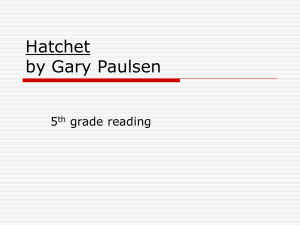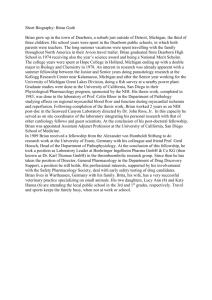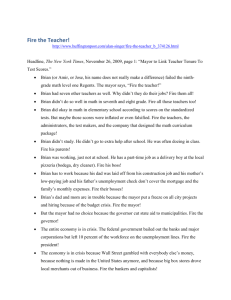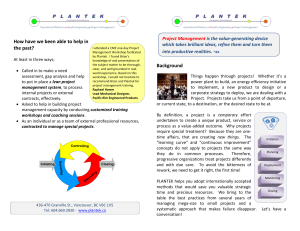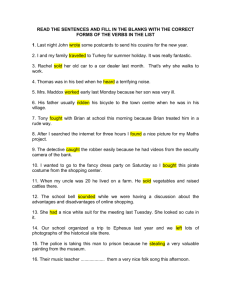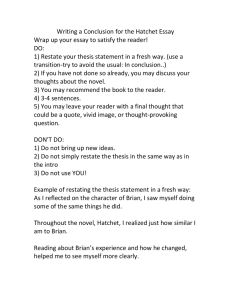Marissa Ina
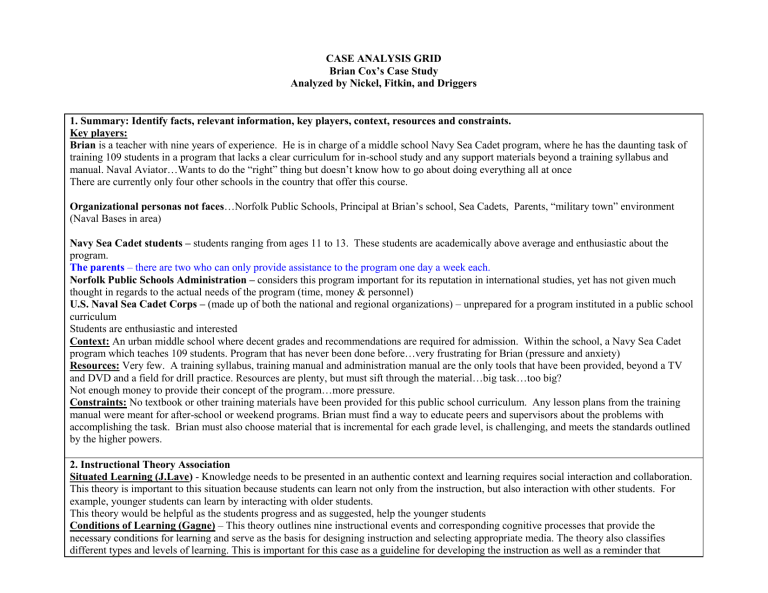
CASE ANALYSIS GRID
Brian Cox’s Case Study
Analyzed by Nickel, Fitkin, and Driggers
1. Summary: Identify facts, relevant information, key players, context, resources and constraints.
Key players:
Brian is a teacher with nine years of experience. He is in charge of a middle school Navy Sea Cadet program, where he has the daunting task of training 109 students in a program that lacks a clear curriculum for in-school study and any support materials beyond a training syllabus and manual. Naval Aviator…Wants to do the “right” thing but doesn’t know how to go about doing everything all at once
There are currently only four other schools in the country that offer this course.
Organizational personas not faces …Norfolk Public Schools, Principal at Brian’s school, Sea Cadets, Parents, “military town” environment
(Naval Bases in area)
Navy Sea Cadet students – students ranging from ages 11 to 13. These students are academically above average and enthusiastic about the program.
The parents – there are two who can only provide assistance to the program one day a week each.
Norfolk Public Schools Administration – considers this program important for its reputation in international studies, yet has not given much thought in regards to the actual needs of the program (time, money & personnel)
U.S. Naval Sea Cadet Corps – (made up of both the national and regional organizations) – unprepared for a program instituted in a public school curriculum
Students are enthusiastic and interested
Context: An urban middle school where decent grades and recommendations are required for admission. Within the school, a Navy Sea Cadet program which teaches 109 students. Program that has never been done before…very frustrating for Brian (pressure and anxiety)
Resources: Very few. A training syllabus, training manual and administration manual are the only tools that have been provided, beyond a TV and DVD and a field for drill practice. Resources are plenty, but must sift through the material…big task…too big?
Not enough money to provide their concept of the program…more pressure.
Constraints: No textbook or other training materials have been provided for this public school curriculum. Any lesson plans from the training manual were meant for after-school or weekend programs. Brian must find a way to educate peers and supervisors about the problems with accomplishing the task. Brian must also choose material that is incremental for each grade level, is challenging, and meets the standards outlined by the higher powers.
2. Instructional Theory Association
Situated Learning (J.Lave) - Knowledge needs to be presented in an authentic context and learning requires social interaction and collaboration.
This theory is important to this situation because students can learn not only from the instruction, but also interaction with other students. For example, younger students can learn by interacting with older students.
This theory would be helpful as the students progress and as suggested, help the younger students
Conditions of Learning (Gagne) – This theory outlines nine instructional events and corresponding cognitive processes that provide the necessary conditions for learning and serve as the basis for designing instruction and selecting appropriate media. The theory also classifies different types and levels of learning. This is important for this case as a guideline for developing the instruction as well as a reminder that
different students may learn in different ways. Instruction can be designed to accommodate all of the learning styles as well using the nine events of learning to help sequence the instruction.
Lateral Thinking (DeBono) – this theory emphasizes that a different perspective is often necessary for solving problems. Brian can use this theory in his own planning. Perhaps he needs to come at the problems from a different perspective.
Principles: Operant Conditioning (B.F. Skinner) 1. Behavior that is positively reinforced will reoccur; intermittent reinforcement is particularly effective. 2. Information should be presented in small amounts so that responses can be reinforced ("shaping") 3. Reinforcements will generalize across similar stimuli ("stimulus generalization") producing secondary conditioning.
This would certainly fit with the military component with their drills.
Multiple Intelligences (H. Gardner) Gardner also emphasizes the cultural context of multiple intelligences. Each culture tends to emphasize particular intelligences. For example, Gardner (1983) discusses the high spatial abilities of the Puluwat people of the Caroline Islands, who use these skills to navigate their canoes in the ocean. Gardner also discusses the balance of personal intelligences required in Japanese society.
I think Skinner is good for reinforcing behavior for military drill, order and discipline. In multiple intelligence theory emphasizes the material/resources developed for the culture…in this case military culture.
Algo-Heuristic Theory (L. Linda) – at this level Bob should focus on processes rather than mastery. This program should be designed as an entry into higher levels (high school ROTC) and rely on the “snowball” method of several years of training each teaching the same content at higher level as his students progress through the program.
Cognitive Load Theory (J. Sweller) – these are young students learning concepts that are sometime difficult for “students” in actual boot camp.
Care should be given not to overload the students prior to they have reached the proper maturity. Perhaps only introducing marching and drill to
6 th grade, having a supporting role for 6 th graders, and having actual drilling (honor guard duty, etc.) for his third year students. Something to aspire to once they have learned the schema .
Connectionism (E. Thorndike) – this should be a natural as there are unlimited resources available to illustrate the connection between what they are learning and how it will apply in the military.
Double Loop Learning (C. Argyris) – the basis of this theory is personal change oriented towards professional education, especially leadership.
Elaboration Theory (C. Reigeluth) – instruction should be organized in increasing order of complexity.
Genetic Epistemology (J. Piaget) – the students Brian will be teaching are in the later logical and early formal/abstraction phase.
Collaborative Problem Solving (Nelson) – The use of small groups and a problem based approach could work well for above average students.
The problems selected should attempt to use the interdisciplinary aspect of the program. An example would be an analysis of a famous naval battle looking at leadership, equipment, training.
3. Establish main issues
There is no established model for effectively structuring this program.
Norfolk Public Schools did not do needs analyses before implementing this program.
The curriculum for this program has to extend across three years of a student’s education.
Brian needs to decide what kinds of tools he needs to develop for the program
(possibly a textbook)
Other resources, including surplus Navy uniforms, need to be procured.
Ongoing recruiting will be necessary to keep parents involved.
Brian must wear several different roles all at the same time…very difficult. He is challenged with dividing his time.
Brian must find a way to communicate reality of what can reasonably be accomplished and an ultimate time table to have it finished down the road.
Brian must weigh material and learn to trust his judgment.
Brian is tasked with building a program from scratch. While there are similar programs in the U.S., the other programs are normally conducted as an after school/weekend program with the assistance of parent volunteers.
Brian needs some help-support staff to help in the development and implementation of this program.
4. Identify and describe perspectives:
Brian – basically he is in a one-man band, maybe a one-man orchestra. He feels like he must “do it all” by himself. He is also feeling the pressure of creating a successful program, for his own sake as well as the reputations of
Norfolk Public Schools and the US Navy Sea
Cadet program. Brian wants to do it all and senses he can do it, but there is some doubt.
He wants to succeed, but is put off with unrealistic expectations. What drives him is a love for the kids and an opportunity for his program to be something unique and special.
Brian is highly motivated to the success of this program. His background in education and experience in the Navy have provided him with a good foundation on which to build the course.
Students – enthusiastic about participating in this program (and hoping to get their own uniforms soon!) Students enthusiasm will go along way to bless Brain. They want good stuff and are teachable
Student’s parents – also enthusiastic about their children’s involvement in the program and the values they are learning, but so far unwilling to supply help in the classroom
Parents are supportive of the program due to the content yet are unable to provide the level of support normally associated with a program of this nature.
Norfolk Public Schools administration – See this program as one of its “crown jewels” in the quest to attain “World Class status”.
Perhaps they do not realize or are unconcerned about the lack of resources.
NPS wants it NOW and it according to their vision and might become impatient with Brian if he doesn’t act according to their time table.
Principal provides support, but it is a shot in
5. Determine known facts
Brian has experience in both educational and Navy settings, making him a subject matter expert in both areas.
Norfolk Public Schools is counting on this program to be successful.
The U.S. Navy Sea Cadet program has made themselves available as a resource, but is currently unprepared for this situation.
Brian has support from his Principal, but not what it needs to be.
NPS does not understand the complexity of the Navy Culture and the constraints of infusing a program without proper resources.
Students will do well no matter what…seem to want to learn.
Communication isn’t what it needs to be between key persons.
Brian has enough material to create a good program
Brian has experience in classroom instruction.
Brian has been provided with a training syllabus, an administration manual, and a training manual. His tasking is to teach military courtesy, rank/rate structure, marching and drill, Naval history, personal hygiene, physical fitness, and leadership.
His budget, as well as other resources normally associated with a program of this nature such as parental involvement and supporting materials, are very limited.
There are similar programs in four other schools in the country
the dark. Probably feels he/she is doing what can be done and doesn’t know what else to do.
While the school system is supportive of this program, as with many organizations, funding is a constraint. As put forth in the case study, the school system desires “a champagne on a beer budget.”
US Navy Sea Cadet program – happy about this program being implemented in a public school curriculum, but unaware that the instructional materials they have prepared are inadequate for this situation.
6. Establish additional information needed
What other resources in this community might be available to Brian? Does the
Navy have any kind of community outreach program that might be able to help with uniforms as well as guest speakers?
How much money is Norfolk Public
Schools willing to give to beef up this program?
Is NPS willing to provide other support staff?
Does NPS administration really know the difficulties Brian is facing?
Who are the people behind the organizations?
What history/relationship does Brian have with these people?
What kind of interest/feel does Brian have regarding the interest Parents have to help him?
What resources are available from other units offering this program?
What are the High School ROTC programs teaching?
What areas should his energies focus on as a natural lead in to follow-on programs?
Is there a certain timeline that must be followed?
7. Generate advice for short-term solution
Brian should contact the Navy to find out what resources (uniforms, guest speakers, etc) he may be able to get from them.
Brian needs to have a serious meeting with the principal and other administrators, outlining the problems that he is facing.
Get on the superintendent’s calendar.
Central administration must be aware of the constraints under which Bob is operating. They should be provided with a list of proposed program goals and a timeline as to when those milestones are expected to be met.
Develop a relationship with the Principal to be an ally for him and so Brian can educate better ways he/she can help.
Brian should begin to develop his instruction with the idea that eventually the older students can serve as mentors to the younger students.
Obtain copies of the curriculum currently employed by ROTC units at both the High
School and College level. Though they will be at a higher level, they will serve as a guide for both “flow and sequencing”.
Instead of expending energy writing a textbook, Brian should gather resources and create worksheets as needed. A textbook may be more appropriate in the future, when the curriculum is more developed. These gathered activities could be organized into a “lab” book based on activities which enhance the curriculum.
Be honest with students’ parents – “I need help!” Find some way to market your need for assistance and resources (perhaps an occasional letter outlining your need for assistants as well as certain resources – uniforms, etc.)
8. Generate advice for long-term solution
The first year or two will require “basic training” for all of the students. As the program grows, the older students can serve as mentors and assistants in the program.
Gather the worksheets and resources that have been used in the course and create a textbook, notebook or online textbook.
Begin with the end in mind and then go backwards at what would be expected of each cadet for each grade level.
Trip to Great Lakes Naval Training center to see how their materials are organized and what is expected from their enlisted sailors.
Attempt to establish some sort of specialized Adopt-a-school program with local military units specifically for this program. Target specific ratings for specific topics such as Boatswain Mates for seamanship, etc.
Establish contact with local active duty and reserve units. Fortunately, in this area there are drilling reservists available at most any time.
Contact the local recruiting office to determine if there is a local pool of
Delayed Entry Pool (DEP) personnel available who may wish to become involved.
Document the requirement for a budget that will support a “world class program.”
1. Need to establish a network for all the programs in the country so resources and ideas can be shared. A website with ideas for handson activiries, field trips, video recommendations, links.
Invite Parents to food and drink and talk to them ways they can help. Try to have others do the mundane stuff- gathering supplies, xeroxing, to free up Brian for the planning.
Visit with other units of this type and observe their process.
1.
Talk to principal – need to find a business partner for the program. Can be a unit in the service (Navy), or a local business partner whose employees have knowledge and experience to share. In a school/business partnership, business provides needed resources in terms of both volunteers and money or materials.
2.
If Sea Scouts still exist as a branch of the
Boy Scouts, and there is a local unit, see if they can help by recommending resource materials, and perhaps volunteers to help with the practical skills (e.g. knot tying)
3.
Brian needs to clearly (and on paper) tell the principal and the school board that he needs help- how about an aide in the classroomor an assistant, even part time?
4.
Visit the other programs that are currently in existence (no need to “re-invent the wheel”
9. Ponder advantages/disadvantages of solutions
Advantages: By communicating with the administration and parents about his needs, Brian may discover resources and assistance that he would otherwise be unaware of. By developing a curriculum where older students become mentors, he is creating his own group of assistants.
The greatest advantage to implementing the solutions above are that it will result in the type of program that Bob and the school system will be proud of as a model for others. Many of the long-term recommendations should yield results for two reasons. First, military personnel are proud of what they do and are normally more than willing to share their “way of life” with others. Secondly, the military still rewards it’s personnel for community involvement.
If Brian can get the help that is essential to the success of the program, he will have more time to put into curriculum development
Disadvantages: He needs to be very careful in is communication with the administration. He does not want them to think it is a failing program and pull the plug. If Bob fails to provide a successful program, the students may well decide to begin a military organization of their own that may one day take over our own and eventually rule the world.
If Brian cannot get the support, he and his students will be discouraged, and the program may not succeed, due to lack of resources.
Brian might find that support will not change and must accept the less for it. Information overload might occur from Great Lakes and make him discouraged.
Brian could lose patience after several attempts to educate NPS and actually cause a decline in help.
This is a huge job, try to tackle this issue in “chunks” to prevent becoming overwhelmed by the task.
10. Anticipated outcomes if client chooses to implement your recommendations
If Brian makes his needs known and creates a “situated learning environment”, his program should successfully turn out students who have learned the values emphasized by the U.S. Navy Sea Cadets.
Brian will solidify his position with NPS for the long-term.
Brian will become the SME for doing this and eventually become a regional manager of these programs with mo money.
Brian will develop a program that instills life-skills that will empower students the rest of their lives.
Bob will find many additional resources from other similar programs and advanced level of similar training such as high school and college level programs. His program will become the model curriculum for other programs who wish to provide more than an after school/weekend program.
Brian will come out on top with a top notch program which is the pride of not only NPS, but also the community (students and parents included)

